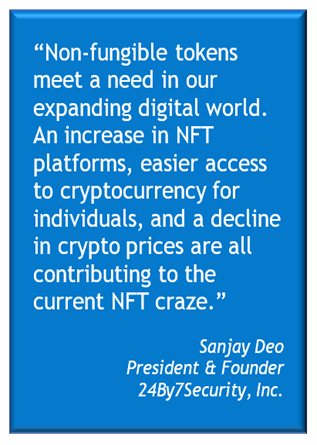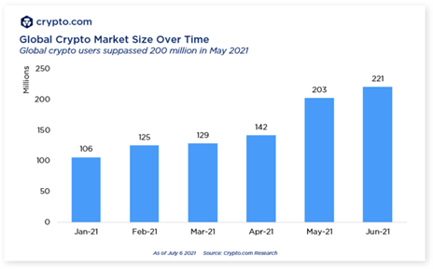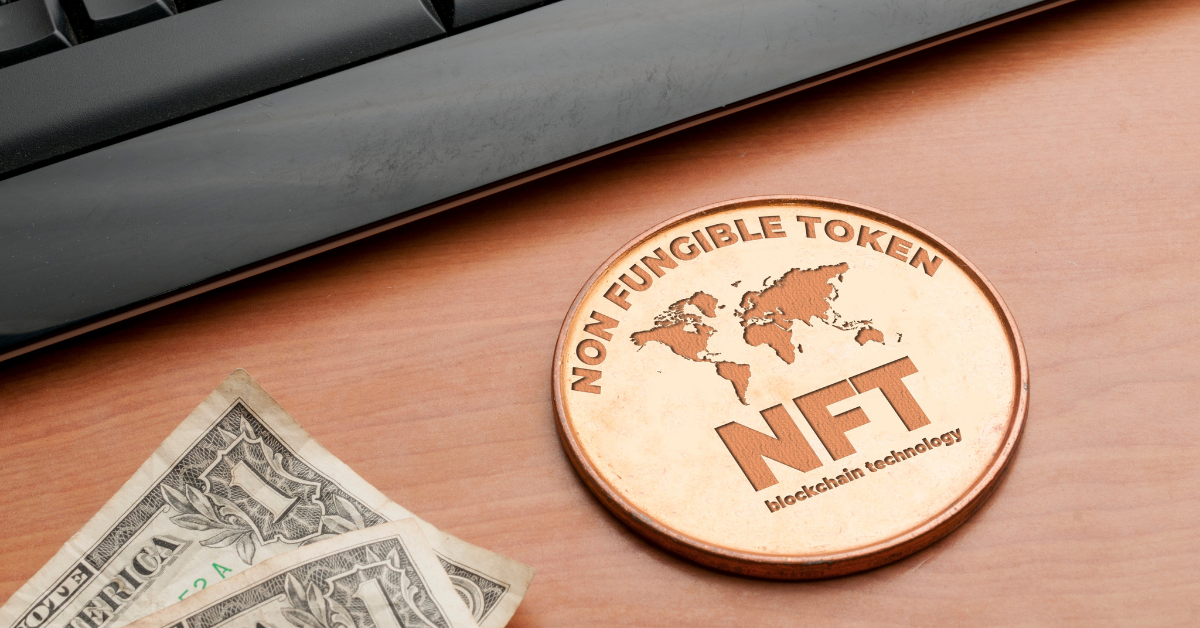The NFT market tripled to $250 million (US cryptocurrency) in a single year, last year, according to the NFT Report for 2020 published by Nonfungible, a leading NFT market tracker. That’s impressive growth.
But wait, there’s more. In just three months in 2021, buyers and investors spent over $200 million in the NFT market, according to Time Magazine. That’s exponential growth.
And while it is not exactly a juggernaut, it would appear that the NFT craze is heating up.
So, what the heck is NFT, and why do we care?
Non-Fungible Tokens (What?!)
Let’s start by defining the important terms here. Fungible vs. non-fungible. And tokens.
Fungible. Fungible refers to goods, items, or things that are interchangeable because, for all practical purposes, they are identical to each other. Some examples include dollar bills, quarters and dimes, bitcoin, shares of common stock, bottles of Dad’s Old Fashioned Root Beer, and white cotton towels.
Non-fungible. Non-fungible, or not fungible, goods, items, or things are unique at the singular level. No two are alike. Each individual item or unit has unique qualities that figure in its value. Some examples include land or real estate, diamonds, original artwork, sports brands, and even human beings.
Tokens. We’re all familiar with subway tokens, Monopoly tokens, and tokens of appreciation. In the context of NFT, a token is something that serves as a visible or tangible representation of something that is not tangible (i.e., that cannot be touched), such as a fact, a quality, or a piece of digital art.
How It Works, Simplified
According to the online encyclopedia, Wikipedia, a non-fungible token (NFT) is a unit of data, or a digital asset, that is stored on a blockchain, or digital ledger. The digital ledger certifies that the digital asset is unique and therefore not interchangeable, as well as who owns it. Owning an NFT normally includes a license to use the underlying or original digital asset, but without transferring copyrights to the NFT buyer unless those are explicitly conveyed.
Through the magic of cryptography, each digital asset is authenticated with a digital signature that, theoretically, can be used to track NFT ownership through the digital ledger. Because NFTs can be traded or sold in cyber markets, using cryptocurrency, ownership tracking is important. In the traditional world of art and antiques, the history of ownership is known as provenance and is an essential element of the item’s value.
Non-fungible tokens can be used to represent digital assets like photos, videos, films, audio, sports brands, original art, and other digital files. However, the types and categories of assets continue to expand and create new applications for non-fungible tokens.
Real World NFT Uses
Our expanding digital world has spawned a need to have representations, or tokens, of a variety of unique digital assets. And although the true introduction of non-fungible tokens can be traced back to 2015, it really didn’t catch fire until 2020.
 ART AND MUSIC. The first uses of NFTs were in the digital art world. Artists creating unique digital art wanted a way to sign, identify, verify, and protect their intellectual property as they launched it into the digital marketplace. Cyber insurance was an unlikely consideration.
ART AND MUSIC. The first uses of NFTs were in the digital art world. Artists creating unique digital art wanted a way to sign, identify, verify, and protect their intellectual property as they launched it into the digital marketplace. Cyber insurance was an unlikely consideration.
To give you a sense of how well this application took hold, consider that a digital artwork by Beeple (a living artist whose given name is Mike Winkelmann) sold for $69.3 million in US cryptocurrency at a Christie’s auction earlier this year.
This new technology has also created opportunities for musicians to publish their works as NFTs. This enables them to profit from sales in the digital marketplace where, not so long ago, digitization led to rampant piracy and revenue theft. Many musicians are also generating NFTs for other content, such as music and video themes, as well as photos and images of the artists and bands.
The first few months of this year have seen numerous large sales of music in the NFT marketplace. The largest occurred in late February when electronic dance music Super DJ Justin Blau sold a collection of 33 NFTs for a total of $11.7 million. The collection commemorated the three-year anniversary of his Ultraviolet album, whose cover art was included among the NFTs. In fact, the month of February 2021 saw a total of $179.4 million in such transactions, according to a Forbes article.
SPORTS. Sports is perhaps the second most popular category of NFTs, after art. One NFT online marketplace, NBA Top Shot, sells tokens of video footage of exciting basketball highlights. In one week’s time this year, NBA Top Shot sold $95 million worth of NFTs in US cryptocurrency. In March, a single video clip of a LeBron James slam dunk sold for more than $200,000, according to CNN Business.
Quarterback Tom Brady has co-founded an NFT platform called Autograph to “bring together the most iconic brands and legendary names in sports, entertainment, and culture to create unique digital collections for users around the world.” (As well as a new revenue stream for those brands and names.)
As one example, on August 11, 2021, Brady launched his own digitally-signed collection of 10,000 NFTs and sold out instantly, according to a press release by DraftKings, a digital sports entertainment and gaming company. The following week, ice hockey legend Wayne Gretsky released his first NFT collection and also sold out within minutes.
On August 31, Olympian gymnast Simone Biles vaulted into cyberspace via Autograph, releasing her collection of 10,000 NFTs with a user-friendly starting price point of $12.
Even Nike is expanding its cyber footprint. In December of 2019, the sports brand acquired a patent for blockchain-compatible sneakers it’s calling CryptoKicks. Catchy. Cryptographically-secured digital assets can be attached to each pair of sneakers, enabling the ownership to be tracked and product authenticity verified. This not only adds unique value to the shoes but also discourages knock-offs, which are prevalent in the industry.
There are many other industries, businesses, and governments that are already beginning to use NFTs or who are exploring the option. And as cryptocurrency becomes easier to acquire and use, one of the last obstacles to online buying and selling of digital assets is being removed.
But is it Secure?
 Like everything else online, if it’s happening on the Internet, it is never totally secure. Cryptocurrency is changing hands in cyberspace at an alarming rate of speed, and the volume of transactions continues to grow without encumbrances such as data encryption.
Like everything else online, if it’s happening on the Internet, it is never totally secure. Cryptocurrency is changing hands in cyberspace at an alarming rate of speed, and the volume of transactions continues to grow without encumbrances such as data encryption.
The global cryptocurrency market more than doubled in size just this year, increasing from 106 million users in January to 221 million users in June. Most market watchers agree that the declining price of bitcoin and other cryptocurrencies has made them more accessible to users, thus driving up the number of users.
While this trend bodes well for the NFT market, it also increases exposure and vulnerability. User crypto accounts, or NFT wallets, operate exclusively online, which makes them vulnerable to hacking when cybersecurity is not as robust as it should be. The greater the volume of transactions, the greater the risk of interference by criminal profiteers. And as more NFT platforms like Autograph come online, the need for serious cybersecurity continues to escalate.
Even the process of registering or minting original artwork in the blockchain has been proven to have exploitable flaws leading to theft and fraud. Ditto the “smart contracts” that form the basis of NFT sales on the most popular NFT blockchain, Ethereum.
For now, white hat hackers are demonstrating some of these vulnerabilities, but chances are cybercriminals are paying close attention. If there is sufficient money to be made from exploiting vulnerabilities, count them in.
Summary
Non-fungible tokens have transformed how art and music are created and sold. Opportunities in the sports industry hold enormous promise and are just beginning to be mined in earnest. Other industries, from entertainment to education and beyond, are testing the waters and selective adoption is sure to follow.
The rise in NFT platforms, ease of individual access to cryptocurrency, and decline in crypto prices are all contributing to the current NFT craze. If cybersecurity can rise to the challenge sooner rather than later, there is no reason for the level of buying and selling activity to decline. Non-fungible tokens clearly meet a need and serve a purpose in our digital universe. Just ask Tom Brady.









